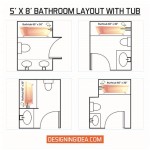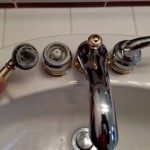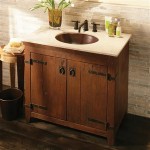Bathroom Sink Sealant Stripes: A Comprehensive Guide
The bathroom sink, a ubiquitous fixture in modern homes, is constantly exposed to water and moisture. This continuous exposure can lead to significant problems if the areas around the sink, particularly where it meets the countertop and the wall, are not properly sealed. Without adequate sealing, water can seep into vulnerable areas, leading to mold growth, structural damage, and costly repairs. Bathroom sink sealant stripes are designed to prevent these issues by creating a watertight barrier.
Sealant stripes, often made of self-adhesive materials like PVC, acrylic, or butyl rubber, offer a convenient and relatively easy-to-apply solution for sealing gaps and preventing water infiltration. They provide an alternative to traditional caulk, promising a cleaner, more uniform appearance and potentially simplifying the installation process. This article will explore the various aspects of bathroom sink sealant stripes, including their types, benefits, installation methods, and considerations for effective use.
Understanding the Types of Bathroom Sink Sealant Stripes
Bathroom sink sealant stripes are not a monolithic product category. Different materials and designs cater to various needs and preferences, impacting their durability, flexibility, appearance, and ease of installation. Understanding these distinctions is crucial for selecting the right sealant stripe for a specific bathroom.
PVC Sealant Stripes: Polyvinyl chloride (PVC) is a common material for sealant stripes due to its affordability and water resistance. PVC stripes are generally rigid and offer decent protection against water damage. However, their rigidity can also be a drawback, making them less suitable for sinks with irregular shapes or corners requiring tight seals. PVC sealant stripes are generally more suited for straight edges and simple sink designs.
Acrylic Sealant Stripes: Acrylic sealant stripes offer improved flexibility compared to PVC. This flexibility allows them to conform better to uneven surfaces and corners, providing a more effective seal in complex installations. Acrylic stripes also tend to be more aesthetically pleasing, often available in a wider range of colors and finishes. They offer good water resistance and are relatively easy to clean. However, they might not be as durable as some other options, particularly in areas with high water exposure.
Butyl Rubber Sealant Stripes: Butyl rubber is known for its excellent adhesion and flexibility. Butyl rubber sealant stripes create a strong, watertight seal, even on slightly irregular surfaces. They are particularly resistant to water damage and temperature fluctuations, making them suitable for bathrooms with high humidity levels. Butyl rubber stripes are generally considered a premium option, often offering a longer lifespan and enhanced performance compared to PVC or acrylic.
Pre-Formed Corner Pieces: Some manufacturers offer pre-formed corner pieces designed to complement their sealant stripes. These corner pieces eliminate the need to cut and miter the stripes precisely at corners, simplifying the installation process and ensuring a clean, professional-looking finish. Using pre-formed corners is especially recommended for individuals with limited experience in DIY projects.
Width and Thickness Considerations: The width and thickness of the sealant stripe are crucial factors to consider. Wider stripes offer better coverage for larger gaps, while thicker stripes provide enhanced durability and water resistance. The appropriate width and thickness will depend on the specific dimensions of the gap between the sink and the countertop or the wall. Carefully measure the gap before selecting a sealant stripe to ensure adequate coverage.
Benefits of Using Sealant Stripes Over Traditional Caulk
Traditional caulk has long been the standard for sealing bathroom sinks. However, sealant stripes offer several potential advantages that make them an attractive alternative for many homeowners.
Ease of Installation: One of the primary benefits of sealant stripes is their ease of installation. Unlike caulk, which requires a steady hand and careful application to achieve a smooth, even bead, sealant stripes are self-adhesive. The backing is peeled away, and the stripe is pressed into place. This simplicity significantly reduces the learning curve and makes sealing the sink accessible to individuals with minimal DIY experience.
Clean and Uniform Appearance: Achieving a professional-looking caulk line requires skill and practice. Even with careful application, caulk can sometimes appear uneven or messy. Sealant stripes, on the other hand, offer a clean and uniform appearance right from the start. The consistent width and thickness of the stripe ensure a visually appealing seal without the need for specialized tools or techniques.
Reduced Mess and Cleanup: Caulking can be a messy process. Excess caulk often needs to be wiped away, and cleaning up caulk residue can be time-consuming. Sealant stripes eliminate much of this mess. There is no excess material to wipe away, and the self-adhesive backing prevents the stripe from sticking to unintended surfaces. This significantly reduces cleanup time and effort.
No Specialized Tools Required: Applying caulk effectively typically requires a caulking gun and potentially smoothing tools. Sealant stripes, however, require minimal tooling. A simple utility knife or scissors may be needed to cut the stripe to length, but no specialized equipment is necessary. This makes sealant stripes a more accessible and convenient option for DIY projects.
Consistency and Predictability: Caulk can shrink and crack over time, requiring periodic reapplication. The performance of caulk can also vary depending on factors such as humidity and temperature during application. Sealant stripes, particularly those made of durable materials like butyl rubber, offer more consistent and predictable performance. They are less prone to shrinkage and cracking, potentially extending the lifespan of the seal.
While sealant stripes offer these advantages, it's important to acknowledge that traditional caulk also has its strengths. Caulk is generally more cost-effective, especially for large projects. High-quality caulk can also offer superior flexibility and long-term durability in certain applications. The choice between sealant stripes and caulk depends on the specific needs and priorities of the homeowner.
Installation and Maintenance of Bathroom Sink Sealant Stripes
Proper installation is crucial for maximizing the effectiveness and longevity of bathroom sink sealant stripes. Careful preparation and a methodical approach will ensure a watertight seal and a professional-looking finish. Regular maintenance will also help to preserve the integrity of the seal and prevent premature failure.
Surface Preparation: The first step in the installation process is to thoroughly clean and dry the surfaces where the sealant stripe will be applied. Remove any existing caulk, dirt, grime, or mildew. Use a scraper or utility knife to carefully remove old caulk, taking care not to damage the surrounding surfaces. Clean the area with a mixture of water and mild detergent, followed by a thorough rinse. Allow the surfaces to dry completely before proceeding.
Measuring and Cutting: Accurately measure the length of the areas where the sealant stripe will be applied. Use a utility knife or scissors to cut the stripe to the required length. For corners, consider using pre-formed corner pieces or carefully mitering the stripe at a 45-degree angle. Precise measurements and clean cuts are essential for a seamless and professional-looking finish.
Application: Peel off a small section of the adhesive backing from the sealant stripe. Position the stripe carefully along the edge of the sink, ensuring that it is aligned correctly. Press the stripe firmly into place, gradually peeling away the remaining adhesive backing and working along the entire length of the stripe. Use your fingers or a smooth, rounded tool to ensure that the stripe is firmly adhered to the surface and that there are no air bubbles or gaps.
Sealing Corners: When applying sealant stripes around corners, take extra care to ensure a watertight seal. If using pre-formed corner pieces, simply press them into place after applying the straight sections of the stripe. If mitering the stripe at a 45-degree angle, ensure that the two pieces fit together snugly and that there is no gap at the corner. Apply a small amount of silicone caulk to the corner for added protection against water infiltration.
Maintenance: Regularly inspect the sealant stripe for signs of damage or wear. Clean the stripe with a damp cloth and mild detergent to remove any dirt or grime. Avoid using harsh chemicals or abrasive cleaners, as these can damage the sealant material. If the stripe begins to peel away from the surface or shows signs of cracking, it should be replaced promptly to prevent water damage.
By following these installation and maintenance guidelines, homeowners can ensure that their bathroom sink sealant stripes provide long-lasting protection against water damage and maintain a clean, aesthetically pleasing appearance.

Bathroom Shower Sink Bath Sealing Strip White 3 35m X 38mm Diy Direct

Bath Sealant Strip Self Adhesive Caulk Strips Waterproof Tape For Bathtub Toilet Floor Corner Wall Shower Tile Sealer Com

Hexoniq Bathroom Sealant Caulk Strip Pe Self Adhesive Tape Waterproof And Anti Mould Seal Wall Sealing For Kitchen Bathtub Sink Toilet Edge Protector Width 3 8 Cm Grey 2

Silicone Bathroom Water Retaining Strip Washing Machine Seal Basin Stove Barrier

Bath Sealant Strip Self Adhesive Caulk Strips Waterproof Tape For Bathtub Toilet Floor Corner Wall Shower Tile Sealer Com

1 Roll Pvc Waterproof Sealing Strip Self Adhesive Sink Stove Kitchen Bathroom Bathtub Corner Sealant Tape Shein Eur

Wall Corner Sealant Strip Temu

3 5m Waterproof Kitchen Sink Clear Tape Mildewproof Nano Bathroom Toilet Crevice Strip Self Adhesive Pool Water Seal Joom

Bathtub Wall Sealing Caulk Strip Pe Self Adhesive Waterproof Tape Sealer Decorative Trim For Kitchen Bathroom Shower Toilet Corner 38mm Muebles Para Baños Pequeños Decoración De Baño

Choose Flexible Trim Strips Over Caulk Instatrim
Related Posts







